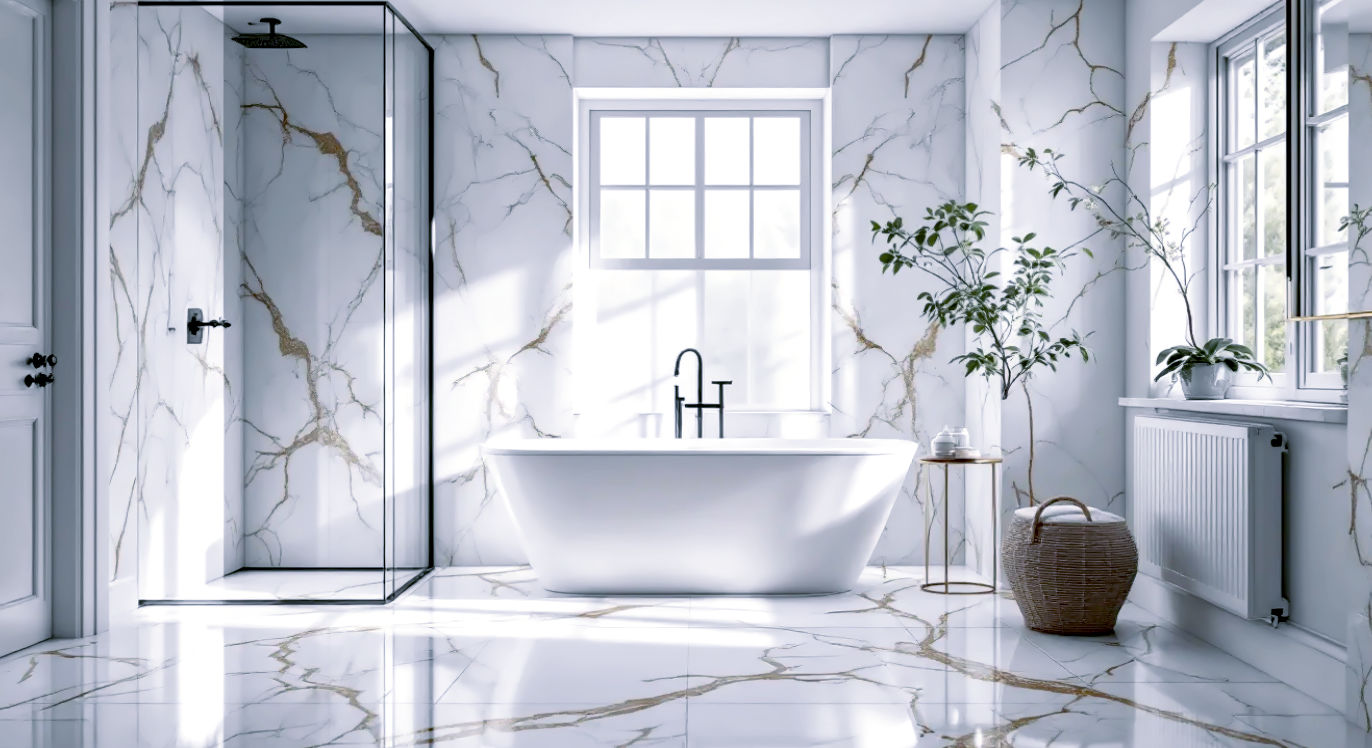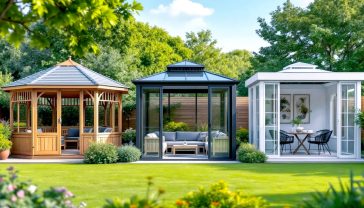The Guide to Marble: From Bathroom Bliss to Flawless Floors
Is marble the right choice for your UK home? Explore our complete guide to marble bathrooms and flooring, covering everything from Carrara to Calacatta.

This post may contain affiliate links. If you make a purchase through these links, we may earn a commission at no additional cost to you.
For centuries, it’s been the stuff of palaces and statues. It’s the stone that Michelangelo used to carve David and the material that lines the grandest halls of London’s museums. We’re talking about marble, of course. A byword for luxury, elegance, and timeless beauty. But is it just for stately homes and five-star hotels? Not anymore.
More and more British homeowners are discovering that marble isn’t just an ancient wonder; it’s a wonderfully practical and beautiful choice for modern homes, especially in bathrooms and on floors. It can turn a dreary downstairs loo into a little jewel box or make a simple hallway feel like a grand entrance.
But let’s be honest. Choosing marble can feel a bit daunting. It sounds expensive, and you’ve probably heard whispers that it’s high-maintenance. Is it too posh? Is it tough enough for a busy family home with muddy boots and spilled Ribena?
This is your definitive guide. We’re going to strip away the mystery and give you the honest truth about bringing this incredible natural stone into your home. We’ll cover everything from the different types you can buy to how much it really costs and how to look after it without any faff. So, grab a cuppa, and let’s talk marble.
First Things First: What Exactly Is Marble?
Before we get into the nitty-gritty, let’s quickly cover what marble actually is. You don’t need a geology degree, but it helps to know what you’re dealing with.
In simple terms, marble is a type of rock that started life as limestone. Think of the stuff that makes up the White Cliffs of Dover. This limestone, formed from ancient sea creatures and shells, gets buried deep within the Earth’s crust. Down there, it’s subjected to immense heat and pressure, which basically cooks and squashes it over millions of years.
This intense process transforms the limestone. Its original calcite crystals grow and interlock, a bit like sugar granules melting and re-forming into a single, solid piece of caramel. It’s this transformation that gives marble its signature crystalline structure and, often, its famous veining.
Those beautiful swirls and veins you see? They’re caused by mineral impurities like clay, silt, or iron oxides that were present in the original limestone. As the rock was being transformed, these impurities were stretched, twisted, and swirled into the unique patterns that make every single slab of marble one-of-a-kind.
So, when you lay a marble floor, you’re literally walking on a piece of ancient geological history. Pretty cool, isn’t it?
A Grand Tour of Marble: The Most Popular Types
Walking into a stone supplier can be overwhelming. You’ll be faced with a sea of slabs, all with fancy Italian-sounding names. While there are hundreds of varieties, most of the marble you’ll find for sale in the UK falls into a few famous families.
Carrara Marble: The Classic All-Rounder
If you picture “marble,” you’re probably picturing Carrara. Hailing from the city of Carrara in Tuscany, Italy, this is the most common and often most affordable type of luxury marble.
- What it looks like: It has a greyish-white or light blue-grey background with soft, feathery, and often quite linear grey veins. The patterning is subtle and delicate.
- Best for: Just about anything. It’s a brilliant choice for bathroom floors, walls, and vanity tops. It’s elegant without being shouty, making it a safe bet for a classic, timeless look.
Calacatta Marble: The Dramatic Showstopper
Also from Italy, Calacatta is often confused with Carrara, but it’s rarer, more expensive, and has a much bolder look. It’s the drama queen of the marble world.
- What it looks like: Calacatta has a much brighter, purer white background than Carrara. Its veins are thick, dramatic, and much less numerous. They often have a brownish or golden hue (this is known as Calacatta Gold).
- Best for: Making a statement. It’s perfect for a feature wall in a shower, a stunning kitchen island, or a grand entrance hall floor where you want people to say “wow.” Because of its bold pattern, it’s often bookmatched, where two adjoining slabs are cut and polished to create a mirror image of each other, like an open book.
Statuario Marble: The Artist’s Choice
The most precious of the Italian marbles, Statuario (or Statuary) is named for its use in creating famous statues. It’s known for its almost luminous quality.
- What it looks like: A bright white background, even whiter than Calacatta, with very few, but dramatic, dark grey veins. The contrast is striking.
- Best for: High-end, super-luxurious applications. Think a five-star hotel lobby or a seriously impressive main bathroom. It’s a symbol of pure opulence.
Emperador Marble: The Warm and Earthy One
Moving away from Italy, we head to Spain for this popular variety. Emperador brings a completely different feel—it’s warm, rich, and earthy.
- What it looks like: It typically comes in a dark or light brown, with fine, irregular white or grey veins that look a bit like a spider’s web.
- Best for: Creating a cosy, traditional, or spa-like bathroom. It pairs beautifully with wood and warm lighting. It can feel very grounding and is a great choice if you find white marble a bit cold.
Nero Marquina Marble: The Bold and Black One
Another Spanish classic, Nero Marquina is the epitome of chic. It’s a deep, dramatic black marble that makes a powerful statement.
- What it looks like: A rich, deep black background with stark, irregular white veins crisscrossing the surface. The contrast is incredibly striking.
- Best for: Creating a moody, contemporary, or Art Deco-style space. It’s fantastic for a powder room floor, a shower wall, or a vanity top. Paired with brass fittings, it looks absolutely incredible.
The Big Debate: Why Choose Marble for Your Home?
So, it’s beautiful. We get it. But is it right for your home? Let’s weigh up the good, the bad, and the slightly inconvenient.
The Pros (The “Absolutely, Yes!” List)
- Unmatched Beauty and Uniqueness: This is marble’s superpower. Because it’s a natural product, no two tiles are ever the same. The unique veining and subtle colour variations create a depth and character that man-made materials just can’t replicate. It adds a layer of soul and sophistication to any room.
- Durability and Longevity: It’s a rock. It has literally been around for millions of years. While it’s not indestructible (we’ll get to that), a well-maintained marble floor or wall will outlast virtually any other finish in your home. Think of the ancient marble floors in Rome—they’re still there!
- Increases Your Home’s Value: In the property market, marble is a huge plus. Estate agents love to mention it. It’s seen as a premium, aspirational feature that signals quality and investment, which can add real value when it’s time to sell.
- Brilliant with Underfloor Heating: Marble is an excellent conductor of heat. This means if you have underfloor heating (a popular choice for chilly British homes), the warmth transfers through the stone quickly and efficiently, making the floor feel wonderfully luxurious underfoot.
- Brightens and Enlarges a Room: Lighter-coloured marbles like Carrara and Calacatta have a naturally luminous quality. A polished marble surface reflects light around the room, which can make smaller British bathrooms or dark hallways feel significantly bigger, brighter, and more open.
The Cons (The “Hold On a Minute” List)
- The Cost: There’s no getting around it—marble is a premium material. It’s one of the more expensive options for flooring and bathrooms. You’re paying for its rarity, beauty, and the cost of quarrying and shipping it from places like Italy and Spain. We’ll break down the costs in more detail later.
- Maintenance is Non-Negotiable: This is the big one. Marble is porous, like a very dense sponge. This means it can absorb liquids, which can lead to stains. It’s also sensitive to acid. A splash of lemon juice, vinegar, or harsh cleaning chemicals can etch the surface, leaving a dull, slightly rough spot. To prevent this, marble must be sealed regularly.
- It’s Softer Than You Think: Compared to granite or man-made porcelain, marble is a relatively soft stone. This means it can be scratched by dragging heavy furniture across it or chipped if you drop something heavy on it. It’s not fragile, but it’s not bulletproof either.
- It Can Be Slippery: A highly polished marble floor in a bathroom can be very slippery when wet. This is a serious consideration, especially if you have children or elderly family members. Thankfully, there are other finishes that offer more grip.
- The Cold Factor: Without underfloor heating, marble can feel very cold underfoot, especially on a winter morning. This might be a bonus during a rare British heatwave, but for the other 50 weeks of the year, it’s something to consider.
Marble in the Bathroom: A Practical Guide
The bathroom is marble’s natural habitat. It creates a clean, serene, spa-like atmosphere that’s hard to beat. Here’s how to use it wisely.
On the Floor
A marble bathroom floor feels incredibly luxurious. As mentioned, it’s a perfect partner for underfloor heating. The main drawback is the slip factor. To combat this, consider a honed finish instead of polished. A honed finish is smooth but has a matte, non-reflective surface that provides much more grip when wet. It also hides water spots and scratches better than a polished surface.
On the Walls and in the Shower
This is where marble truly shines. Cladding a whole bathroom, or just the shower enclosure, in floor-to-ceiling marble creates a seamless, five-star hotel look. It’s a great way to make a small bathroom feel grand.
- Bookmatching: If you’re using a dramatically veined marble like Calacatta, ask your installer about bookmatching a feature wall. It creates a stunning, symmetrical Rorschach test of natural art.
- Waterproofing is Key: Behind the beautiful marble, your installer must use a robust waterproofing system (often called a tanking system). Marble itself isn’t waterproof, so this backing layer is crucial to prevent leaks and damp problems.
- Grout Choice: Use a high-quality, mould-resistant grout. Some people opt for very thin grout lines to create an almost seamless look, but remember that grout is an important part of the waterproofing system.
For Vanity Tops and Sinks
A marble countertop instantly elevates a simple vanity unit. It’s a classic look that works with both modern and traditional designs. However, the vanity top is a high-risk area for spills and etching. Toothpaste, mouthwash, face cleansers, and aftershave can all contain acids that can damage the surface. Be vigilant with wiping up spills immediately.
Marble Flooring: Stepping into Style Beyond the Bathroom
Marble isn’t just for wet rooms. It can bring a sense of grandeur to other areas of your home.
Hallways and Entrances
A marble floor makes a fantastic first impression. It’s durable enough to handle foot traffic and immediately signals a sense of quality and style. Lighter marbles can make a narrow British hallway feel wider and more welcoming.
Kitchens
A marble kitchen floor is a brave but beautiful choice. The main challenge is the high risk of spills. A dropped glass of red wine or a splash of lemon juice needs to be wiped up instantly. Many people feel it’s too much of a risk, but for those who love the look and are prepared for the maintenance, it can be stunning. Again, a honed finish is much more practical here than a polished one.
Finishes Matter: Polished vs. Honed
We’ve mentioned this a few times, but it’s one of the most important decisions you’ll make.
- Polished Finish: This is the classic, high-gloss, reflective finish you see in posh hotels. It brings out the colour and veining of the stone beautifully and makes a room feel brighter. However, it is slippery when wet and shows every single scratch and water spot. Best for walls or low-traffic floors.
- Honed Finish: This finish is created by sanding the surface to a smooth, flat, matte (non-shiny) finish. It has a softer, more contemporary look. Crucially, it offers more grip and is much more forgiving of scratches and etching. The colours will be slightly more muted than on a polished stone. This is the recommended finish for most bathroom and kitchen floors.
The Marble Owner’s Manual: How to Look After It
Don’t be scared by the maintenance talk. Looking after marble is more about having the right routine and products than it is about hard work.
Sealing is Your Shield
This is the most important rule. Your marble must be sealed. A sealer is a chemical that you apply to the surface. It soaks into the pores of the stone and acts like a protective raincoat, preventing liquids from soaking in and causing stains.
- When to Seal: Your installer should seal the marble upon installation. After that, you’ll need to re-seal it every 6-12 months, depending on how much use the area gets.
- The Water Test: Not sure if it needs sealing? Drip a small puddle of water onto the surface. If it sits there in a tight bead, your sealer is working. If it soaks in and darkens the stone after a few minutes, it’s time to re-seal.
The Daily Clean: Be Gentle
Cleaning marble is easy, as long as you use the right stuff.
- DO USE: A few drops of a pH-neutral stone cleaner mixed with warm water. You can buy these from tile shops or online. A microfibre mop or cloth is perfect.
- DON’T USE: Anything acidic or abrasive. This means no vinegar, no lemon juice, no bleach-based products (like Cillit Bang), and no scouring powders (like Cif cream). These will strip the sealer and etch the surface of the marble itself.
Emergency Procedure: Dealing with Spills
Accidents happen. The key is to act fast.
- Blot, Don’t Wipe: If you spill something like red wine or coffee, don’t wipe it, as this can spread the stain. Gently blot the spill with a clean, absorbent cloth.
- Rinse: Clean the area with your pH-neutral cleaner and rinse with plain water.
- For Tough Stains: For oily stains or stubborn marks, you might need a special poultice, which is a paste that draws the stain out of the stone. You can buy these from stone care specialists.
The Cost Question: What’s the Real Damage?
Let’s talk money. The price of marble in the UK can vary wildly based on the type, quality, and thickness.
- The Stone Itself: Expect to pay anywhere from £50 per square metre for a basic Carrara tile up to £250+ per square metre for a premium slab of Calacatta or Statuario.
- Installation: Installing marble is a specialist job. It’s heavier and more delicate than ceramic tile. You’ll need an experienced tiler who knows how to work with natural stone. Installation costs can range from £50 to £100 per square metre, sometimes more for complex patterns or large format slabs.
- The Extras: Don’t forget to budget for adhesive, grout, sealer, and potentially a waterproof tanking system for a bathroom.
Total Project Cost (Rough Guide): For a small bathroom floor (around 5 sq/m), you could be looking at a total cost of £750 – £2,000+. For a larger area, the price increases accordingly. It’s a significant investment, but one that adds lasting value.
Can’t Afford the Real Deal? Faking It Brilliantly
If you love the look of marble but the cost or maintenance puts you off, don’t despair. The modern alternatives are astonishingly good.
- Marble-Effect Porcelain Tiles: This is the number one alternative. Modern printing technology allows manufacturers to create porcelain tiles that are almost indistinguishable from real marble. Porcelain is incredibly hard, non-porous (so it doesn’t need sealing), and much more affordable. You get 95% of the look with 0% of the worry.
- Luxury Vinyl Tile (LVT): Brands like Karndean and Amtico produce very realistic marble-effect vinyl tiles. They are warm underfoot, completely waterproof, and very durable, making them a fantastic, family-friendly choice for bathrooms.
So, Is Marble Right for You? The Final Verdict
Choosing marble is a decision of the heart as much as the head.
It’s not the easiest or the cheapest option. It asks for a little more care and attention than a simple ceramic tile. It will develop a patina over time—a few minor scratches or faint water marks that tell the story of its life in your home. Some people call this character; others call it imperfection.
But what you get in return is something truly special. You get a surface of unique, natural beauty that has an elegance and a sense of permanence that no other material can quite match. It’s a connection to the natural world and a piece of timeless design that will bring you joy every single day.
If you’re someone who appreciates quality, loves classic style, and is prepared to give your home a little bit of love, then yes, marble is an absolutely brilliant choice. It’s an investment, for sure, but one that will pay you back with a lifetime of beauty.
Further Reading:






